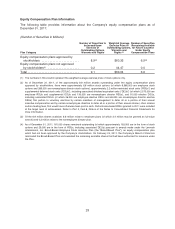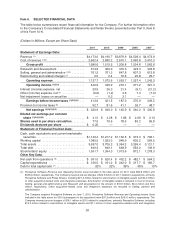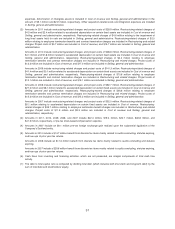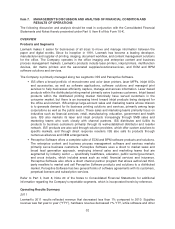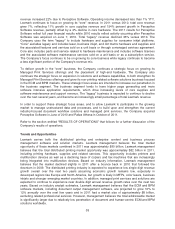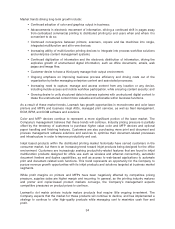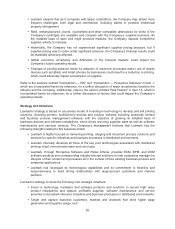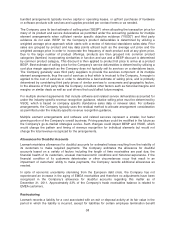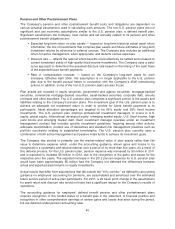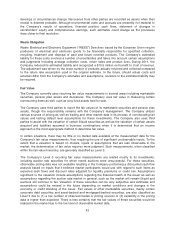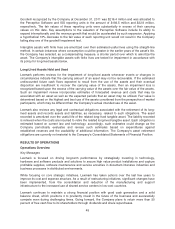Lexmark 2011 Annual Report Download - page 43
Download and view the complete annual report
Please find page 43 of the 2011 Lexmark annual report below. You can navigate through the pages in the report by either clicking on the pages listed below, or by using the keyword search tool below to find specific information within the annual report.charges that are accrued over time. Employee termination benefits associated with an exit or disposal
activity are accrued when the obligation is probable and estimable as a postemployment benefit
obligation when local statutory requirements stipulate minimum involuntary termination benefits or, in
the absence of local statutory requirements, termination benefits to be provided are similar to benefits
provided in prior restructuring activities. Employee termination benefits accrued as probable and
estimable often require judgment by the Company’s management as to the number of employees
being separated and the related salary levels, length of employment with the Company and various
other factors related to the separated employees that could affect the amount of employee termination
benefits being accrued. Such estimates could change in the future as actual data regarding separated
employees becomes available.
Specifically for termination benefits under a one-time benefit arrangement, the timing of recognition
and related measurement of a liability depends on whether employees are required to render service
until they are terminated in order to receive the termination benefits and, if so, whether employees will
be retained to render service beyond a minimum retention period. For employees who are not required
to render service until they are terminated in order to receive the termination benefits or employees
who will not provide service beyond the minimum retention period, the Company records a liability for
the termination benefits at the communication date. If employees are required to render service until
they are terminated in order to receive the termination benefits and will be retained to render service
beyond the minimum retention period, the Company measures the liability for termination benefits at
the communication date and recognizes the expense and liability ratably over the future service period.
For contract termination costs, Lexmark records a liability for costs to terminate a contract before the
end of its term when the Company terminates the agreement in accordance with the contract terms or
when the Company ceases using the rights conveyed by the contract. The liability is recorded at fair
value in the period in which it is incurred, taking into account the effect of estimated sublease rentals
that could be reasonably obtained which may be different than company-specific intentions.
Warranty
Lexmark provides for the estimated cost of product warranties at the time revenue is recognized. The
amounts accrued for product warranties are based on the quantity of units sold under warranty,
estimated product failure rates, and material usage and service delivery costs. The estimates for
product failure rates and material usage and service delivery costs are periodically adjusted based on
actual results. For extended warranty programs, the Company defers revenue in short-term and long-
term liability accounts (based on the extended warranty contractual period) for amounts invoiced to
customers for these programs and recognizes the revenue ratably over the contractual period. Costs
associated with extended warranty programs are expensed as incurred. To minimize warranty costs,
the Company engages in extensive product quality programs and processes, including actively
monitoring and evaluating the quality of its component suppliers. Should actual product failure rates,
material usage or service delivery costs differ from the Company’s estimates, revisions to the
estimated warranty liability may be required.
Inventory Reserves and Adverse Purchase Commitments
Lexmark writes down its inventory for estimated obsolescence or unmarketable inventory equal to the
difference between the cost of inventory and the estimated market value. The Company estimates the
difference between the cost of obsolete or unmarketable inventory and its market value based upon
product demand requirements, product life cycle, product pricing and quality issues. Also, Lexmark
records an adverse purchase commitment liability when anticipated market sales prices are lower than
committed costs. If actual market conditions are less favorable than those projected by management,
additional inventory write-downs and adverse purchase commitment liabilities may be required.
39


